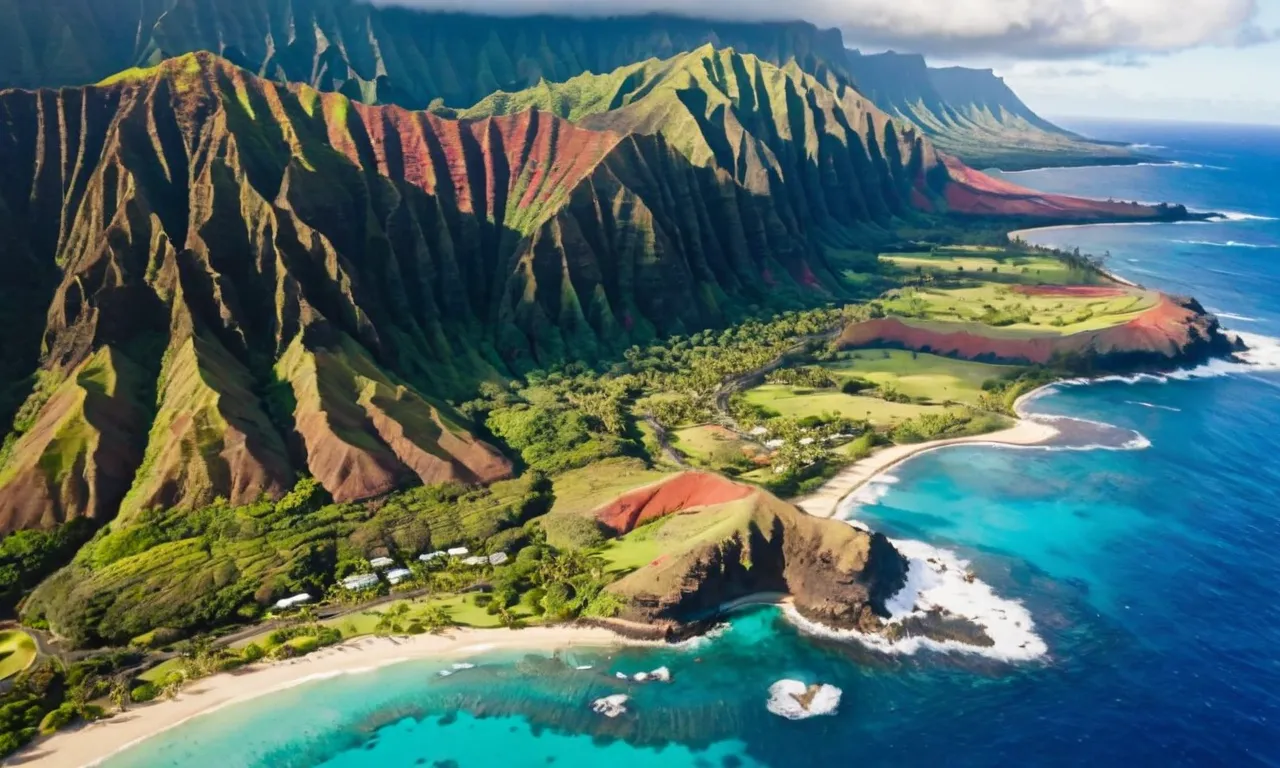When Will Hawaii Sink?
The tropical paradise of Hawaii conjures images of sunny beaches, towering volcanoes, and hula dancers. But could this Pacific island chain one day slip beneath the waves? If you’re short on time, here’s a quick answer: Current predictions estimate Hawaii will remain above sea level for at least another 100,000 years.
In this comprehensive article, we’ll explore the geological forces that created the Hawaiian islands, examine research into sea level rise, and consider whether the extinction of low-lying atolls provides a glimpse into Hawaii’s future.
With over 20 headings organized into 5 sections, you’ll gain an in-depth understanding of the scientific factors influencing Hawaii’s elevation over time.
Origins and Formation of the Hawaiian Islands
The Hawaiian Islands are a remarkable result of geological processes that have been at work for millions of years. The formation of these islands is closely tied to the movement of tectonic plates and the hotspot volcanism that occurs in the Pacific Ocean.
Hotspot Volcanism and Plate Tectonics
The Hawaiian Islands are located near the middle of the Pacific Plate, which is slowly moving in a northwestern direction. Deep beneath the Earth’s surface, a hotspot exists, where plumes of molten rock, or magma, rise up from the mantle.
This hotspot has remained relatively stationary while the Pacific Plate has been moving over it. As a result, a chain of volcanic islands has formed, with the youngest islands forming over the hotspot and the older islands being pushed away due to plate movement.
The formation of the Hawaiian Islands is a prime example of plate tectonics, the theory that describes the movement and interactions of Earth’s lithosphere. The Pacific Plate’s movement over the hotspot has created a linear chain of volcanic islands, with each island representing a stage in the island-building process.
Lava Flows Creating the Island Chain Over Millions of Years
Over millions of years, the Hawaiian Islands have been built up by repeated eruptions of lava from the hotspot. When the magma reaches the surface, it erupts as lava, which flows out and solidifies, adding to the size and height of the island.
As more eruptions occur, the island grows in size, both above and below sea level.
This process of lava flows and eruptions has repeated itself countless times, resulting in the formation of the entire island chain. Each island is made up of multiple volcanic mountains, some of which are still active today.
The Big Island of Hawaii, for example, is home to the active volcanoes Mauna Loa and Kilauea.
Erosion and Changing Coastlines
While the creation of the Hawaiian Islands is a dynamic process, erosion also plays a significant role in shaping the islands over time. The constant action of wind, water, and waves erodes the volcanic rock, carving out valleys, cliffs, and beaches.
Coastlines in Hawaii are constantly changing due to erosion. In some areas, the land is slowly being eroded away, while in others, new land is being formed as lava flows into the ocean and solidifies. The unique combination of volcanic activity and erosion has created the diverse landscapes that make Hawaii such a breathtaking destination.
To learn more about the geological processes that have shaped the Hawaiian Islands, you can visit www.nps.gov/havo/learn/nature/geologicformations.htm, a website provided by the National Park Service that offers detailed information and resources on the subject.
Current Predictions on Sea Level Rise
Global Climate Change Models
Scientists and researchers use global climate change models to make predictions about future sea level rise. These models take into account various factors such as greenhouse gas emissions, ice melting rates, and ocean currents.
According to the Intergovernmental Panel on Climate Change (IPCC), if greenhouse gas emissions continue at their current rate, global sea levels could rise by an average of 0.5 to 1.2 meters (1.6 to 3.9 feet) by the end of the century.
These predictions are based on a range of scenarios and may vary depending on future actions to mitigate climate change.
Localized Hawaii Land Subsidence Estimates
In addition to global climate change models, scientists also consider localized factors when predicting sea level rise in specific regions such as Hawaii. One important factor is land subsidence, which refers to the sinking of land due to natural or human-induced causes.
In the case of Hawaii, volcanic activity and groundwater extraction are contributing factors to land subsidence. According to a study published in the journal Geophysical Research Letters, the island of Oahu is experiencing an average subsidence rate of about 0.7 millimeters per year.
This localized subsidence can amplify the effects of sea level rise in Hawaii.
Measuring Sea Levels with Tide Gauges and Satellites
To track sea level rise, scientists use a combination of tide gauges and satellite measurements. Tide gauges are instruments installed along coastlines that measure the height of the ocean surface relative to a reference point on land.
These measurements provide valuable data on long-term sea level trends. Satellites, on the other hand, use radar altimetry to measure the distance between the satellite and the ocean surface, allowing for precise measurements of sea level changes.
The combination of tide gauge and satellite data helps scientists monitor global and regional sea level rise.
For more information on current sea level rise predictions and research, you can visit the Intergovernmental Panel on Climate Change (IPCC) or the Nature website.
When Low-Lying Atolls May Sink Beneath the Waves
Case Study: The Marshall Islands are Disappearing
The Marshall Islands, located in the Pacific Ocean, are facing the imminent threat of sinking beneath the waves. This low-lying atoll nation consists of more than 1,200 small islands and islets, most of which sit less than six feet above sea level.
Rising sea levels and the increased frequency and intensity of storm surges have already caused significant erosion and coastal flooding in the Marshall Islands. According to a study conducted by the University of Hawai’i, the average sea level rise in the Marshall Islands has been 3.2 millimeters per year since the early 1990s, which is significantly higher than the global average of 1.7 millimeters per year.
The situation in the Marshall Islands serves as a stark reminder of the vulnerability of low-lying atolls to the impacts of climate change. The government of the Marshall Islands has been working tirelessly to mitigate the effects of sea-level rise, but without global cooperation and significant efforts to reduce greenhouse gas emissions, the future of the Marshall Islands remains uncertain.
Factors Accelerating the Demise of Atolls
Several factors contribute to the accelerated demise of atolls such as the Marshall Islands. One of the primary factors is the rising sea levels caused by global warming. As the polar ice caps melt and ocean temperatures rise, sea levels continue to increase, posing a significant threat to low-lying coastal areas.
Additionally, the increased frequency and intensity of storms and storm surges exacerbate the erosion and flooding of atolls, gradually eroding the land and making it more susceptible to submersion.
Human activities also play a role in the sinking of atolls. The extraction of groundwater from the underlying aquifers can lead to land subsidence, causing the atolls to sink further. Improper land-use practices, such as deforestation and unsustainable development, can also contribute to the erosion and degradation of atoll environments, further increasing the risk of sinking.
Contrasting the Higher Elevations of the Main Hawaiian Islands
While low-lying atolls like the Marshall Islands face the threat of sinking, the main Hawaiian Islands offer a contrasting example. Unlike atolls, the main Hawaiian Islands are volcanic in origin and have higher elevations, ranging from sea level to over 13,000 feet at the summit of Mauna Kea.
The mountainous terrain provides a natural defense against rising sea levels and storm surges.
However, it is important to note that even the main Hawaiian Islands are not entirely immune to the impacts of climate change. Rising sea levels can still lead to coastal erosion and flooding in low-lying areas, and extreme weather events can cause significant damage.
The state of Hawaii has been actively implementing adaptation strategies to protect vulnerable coastal communities and ecosystems.
For more information on the impacts of climate change on atolls and the efforts to mitigate these effects, visit the Climate.gov website.
Future Outlook and Estimated Timescales
Wondering when Hawaii will sink? Don’t worry, the current scientific consensus is that Hawaii is stable for the next 100,000+ years. So, if you’re planning a vacation to the beautiful islands, you can rest assured that they will be there for generations to come.
Current Scientific Consensus: Hawaii Stable for 100,000+ Years
Scientists have been studying the geological processes of Hawaii for decades, and their findings indicate that the islands are not at immediate risk of sinking. The volcanic activity that created Hawaii is still ongoing, with new islands forming as we speak.
While individual islands may erode over time due to wave action and other natural forces, the overall landmass of Hawaii is expected to remain stable for the foreseeable future.
One key reason for this stability is the hotspot theory, which suggests that Hawaii sits atop a stationary plume of hot magma deep within the Earth’s mantle. As the Pacific tectonic plate moves over this hotspot, new volcanoes are formed, adding to the landmass of Hawaii.
This continuous volcanic activity helps to counterbalance any erosion that may occur.
Variables and Uncertainties in Long-Term Modeling
While the scientific consensus is reassuring, it’s important to note that there are some variables and uncertainties when it comes to long-term modeling. Climate change and sea-level rise, for example, could potentially impact the future stability of Hawaii.
However, current research suggests that these factors are not significant enough to pose an immediate threat to the islands.
Additionally, scientists are constantly improving their understanding of geological processes and developing more accurate prediction models. With advanced monitoring systems and sophisticated technology, they are able to detect even the smallest changes in the Earth’s crust.
This allows them to better assess any potential risks and make more accurate predictions about the future of Hawaii.
Monitoring Ongoing Changes with Improved Prediction Capabilities
Monitoring ongoing changes in Hawaii is crucial for understanding the long-term stability of the islands. Scientists use a variety of tools and techniques to track volcanic activity, erosion rates, and other geological processes.
This data helps them refine their models and make more accurate predictions about the future of Hawaii.
One such example is the Hawaiian Volcano Observatory, which has been monitoring volcanic activity in Hawaii since 1912. Through their research and monitoring efforts, they provide valuable information about the current state of the volcanoes and any potential risks they may pose.
It’s important to remember that predicting the future is not an exact science. While the current scientific consensus suggests that Hawaii will remain stable for the next 100,000+ years, there are always uncertainties and variables to consider.
However, with ongoing research and improved prediction capabilities, scientists are better equipped to monitor and understand any changes that may occur in the future.
Preparing and Adapting for the Future
As climate change continues to impact our planet, it is crucial to consider the potential consequences for vulnerable regions such as Hawaii. The rising sea levels and increased frequency of extreme weather events pose a significant threat to the islands.
While the question of when Hawaii will sink remains uncertain, it is essential to start preparing and adapting for the future.
Planning for Gradual Coastal Impacts
One way to prepare for the potential impacts of rising sea levels is by planning for gradual coastal changes. This involves assessing the vulnerability of different areas and implementing strategies to protect critical infrastructure and communities.
Measures such as building seawalls, restoring natural coastal defenses like mangroves, and implementing effective land-use policies can help mitigate the effects of erosion and flooding. Additionally, investing in research and monitoring systems can provide valuable data for informed decision-making.
According to a study published in the journal Nature Communications, Hawaii’s sea levels have been rising at a rate of about 3 millimeters per year over the past century. While this may seem like a small increase, the cumulative effect over time can be significant.
By planning for gradual coastal impacts, Hawaii can take proactive steps to protect its unique ecosystems and ensure the safety of its residents.
Considering Managed Retreat Options
Another strategy to adapt to the potential sinking of Hawaii is to consider managed retreat options. This involves relocating communities and infrastructure away from vulnerable coastal areas to safer locations.
While this may seem like a drastic measure, it is a necessary step to ensure the long-term viability and sustainability of the islands.
Managed retreat is not a new concept; it has been successfully implemented in other parts of the world facing similar challenges. For example, the Carteret Islands in Papua New Guinea, which faced severe coastal erosion and flooding, made the decision to relocate its entire population to higher ground.
This proactive approach allowed the community to avoid the devastating impacts of rising sea levels.
Imagining Life if Hawaii Does Become Uninhabitable
While it is essential to take proactive steps to mitigate the impacts of climate change, it is also crucial to consider the possibility that Hawaii may become uninhabitable in the future. This scenario, though challenging to imagine, requires us to think about alternative solutions and potential consequences.
One possibility could be the development of floating cities or offshore communities that can withstand rising sea levels. These innovative solutions, although ambitious, could provide a way for people to continue living in the Hawaiian Islands even if the land becomes uninhabitable.
Additionally, exploring opportunities for migration and relocation to other parts of the world should also be considered.
It is crucial to emphasize that the sinking of Hawaii is not an imminent event, but rather a potential long-term consequence of climate change. By preparing and adapting for the future now, Hawaii can minimize the impacts of rising sea levels and ensure the safety and well-being of its residents for generations to come.
Conclusion
While the eventual submersion of Hawaii remains a distant possibility, the geological forces shaping the islands over millions of years remain active today. Tracking sea level rise, erosion rates, and land elevation will provide greater certainty around projected timescales for Hawaii’s future.
Rather than viewing the prospect of a underwater Hawaii with despair, we can approach the reality of climate change with level-headed preparedness and longer-term adaptation strategies should the need arise in decades and centuries to come.








